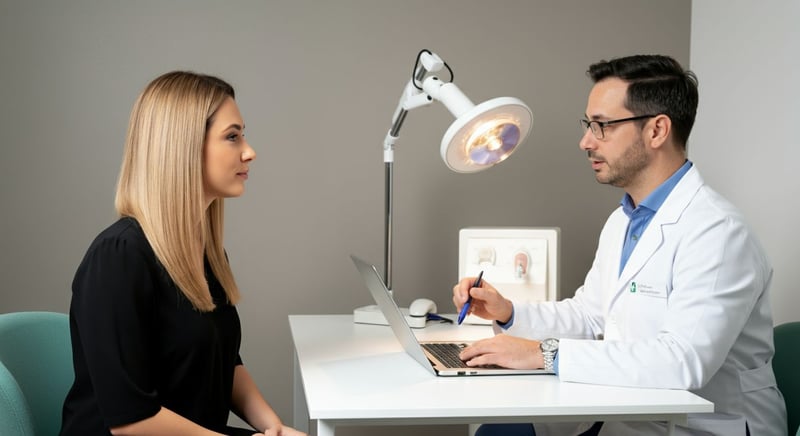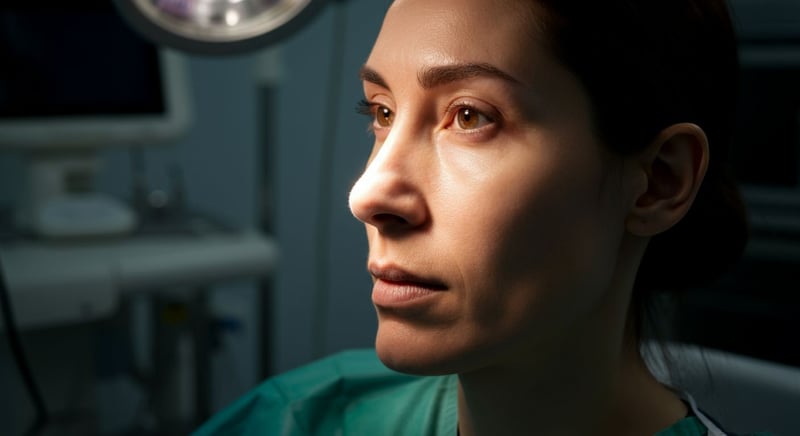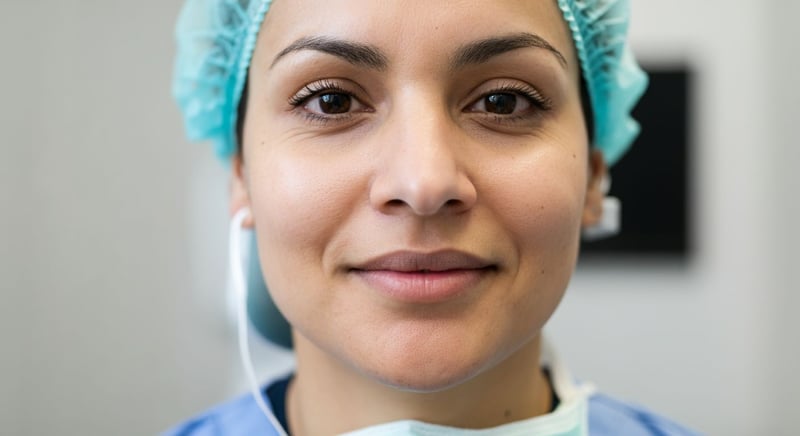Rhinoplasty Unveiled: Sculpting Confidence, One Breath at a Time
Rhinoplasty at estethica: where artistry meets medical precision to sculpt confidence and improve every breath.
Rhinoplasty, often termed as a 'nose job,' is more than just altering physical appearance. It’s about enhancing functionality and breathing ease, while boosting confidence with every breath taken. As estethica’s vision embraces innovative healthcare with patient safety at its forefront, a rhinoplasty procedure carried out here promises aesthetic and functional excellence, recognized by international benchmarks and awards.
What is Rhinoplasty and is it Right For You?
Rhinoplasty is a surgical procedure that modifies the shape of the nose either for aesthetic purposes or to improve nasal function and breathing. Is it the right choice for you? If you're considering a change in the nose structure for better breathing or for correcting disfigurements, this procedure might be worth considering. Deciding on rhinoplasty usually involves a comprehensive consultation to ensure alignment with your aesthetic goals and breathing needs.
Understanding Nasal Reconstruction
Often, individuals seek out rhinoplasty not only for cosmetic reasons but also to correct breathing problems caused by structural issues within the nose. Nasal reconstruction, a facet of rhinoplasty, addresses these functional concerns, and it can be instrumental in improving your quality of life. As an example, a person with a deviated septum might find that a septoplasty, often combined with rhinoplasty, can significantly ease their breathing.
Consider ethnic rhinoplasty, a specialized approach that respects and enhances the unique characteristics of different ethnic noses, or revision rhinoplasty, which corrects issues from a previous nose surgery. Piezoelectric rhinoplasty, a modern technique using ultrasonic tools, facilitates precise bone reshaping with minimized trauma. These are just a few examples of how modern nose surgery adapts to various patient requirements.
Considerations for Choosing Rhinoplasty
- Evaluate your motivations: Are you seeking cosmetic enhancement or functional improvement? Understanding your goals is the first step. As an example, someone might seek a nose job after an injury has caused a visible disfigurement.
- Consult with experienced surgeons: Discuss your expectations and assess their expertise with various rhinoplasty techniques like open rhinoplasty or closed rhinoplasty.
- Recovery preparedness: Be aware of the typical rhinoplasty recovery time and any required aftercare, so you can properly prepare for the recovery process.

Beyond Aesthetics: Rhinoplasty for Breathing and Functional Benefits
While rhinoplasty is popularly associated with aesthetic enhancement, its role in alleviating breathing issues cannot be overstated. Conditions like septum deviation, which can significantly impact airflow and breathing, are expertly addressed through rhinoplasty. This procedure thus serves a dual purpose, marrying aesthetic transformation with respiratory health improvement.
Improving Breathing with Rhinoplasty
Rhinoplasty extends beyond cosmetic improvements by correcting structural anomalies that hinder proper nasal function. For instance, individuals with chronic sinusitis may discover that nasal surgery, particularly when tailored by a skilled surgeon specializing in facial plastic surgery, can open up nasal passages, thus reducing the frequency of infections. Similarly, those experiencing sleep apnea related to nasal obstruction might find significant relief through rhinoplasty coupled with septoplasty.
Consider the modern advances like piezoelectric rhinoplasty, which refine bone structure delicately, proving especially advantageous for patients needing both aesthetic and functional corrections. Rhinoplasty is not just about reshaping the nose; it’s about enhancing overall well-being by ensuring that the nose functions as it should, contributing to better health and improved lifestyle.
Benefits of Functional Rhinoplasty
- Correcting Septal Deviations: Straightening a deviated septum improves airflow, drastically reducing breathing difficulties. For example, a patient who struggled with exercise due to limited nasal airflow found their stamina greatly improved after septal correction through rhinoplasty.
- Alleviating Sinus Issues: Rhinoplasty can open nasal passages, helping to reduce recurrent sinus infections. For instance, enhanced drainage can ease sinus pressure.
- Improving Sleep Quality: By resolving nasal obstructions, rhinoplasty can diminish sleep disturbances like snoring and sleep apnea, leading to more restful sleep. A good example is a person with sleep apnea can experience fewer interruptions during sleep.

Rhinoplasty Recovery: A Comprehensive Guide to Healing and Results
Recovery post-rhinoplasty is a journey back to both aesthetic satisfaction and improved respiratory health. Patients are advised to follow tailored aftercare regimens; these include avoiding strenuous activities and keeping the head elevated. Typically, full recovery can span several weeks, with swelling reducing gradually to reveal the refined nose shape.
Navigating the Rhinoplasty Recovery Timeline
The rhinoplasty recovery period is crucial for achieving the best possible results. Initially, patients might experience swelling and bruising, which typically subside within the first two weeks. Following your surgeon's instructions is paramount. For instance, you may be advised to use cold compresses to minimize swelling or to avoid certain foods that require excessive chewing.
Long-term recovery involves the gradual settling of nasal tissues. Examples include the subtle refinement of the nasal tip and the complete resolution of internal swelling, which affects breathing. The final aesthetic results are usually appreciated several months following the surgery, exemplifying the lasting impact of a well-performed nose job. Individuals may experience the most fulfilling results, especially if they have functional enhancements achieved alongside cosmetic corrections, further enriching their quality of life. Non surgical nose can assist for small aesthetic touches if needed after the rhinoplasty.
Essential Steps for Optimal Healing
- Adhere to Post-Operative Instructions: Meticulously follow all guidelines provided by your surgeon to reduce complications. As an example, keep the splint clean and dry to prevent infection.
- Manage Swelling and Bruising: Apply cold compresses as directed to alleviate discomfort. An example of this could be applying cold compresses for 20 minutes every few hours to minimize swelling.
- Limit Physical Exertion: Avoid strenuous activities that could elevate blood pressure or risk trauma to the nose. For example, taking a break from the gym can significantly decrease the risk of injury.

Finding the Best Rhinoplasty Surgeon: Expertise, Artistry, and Personalized Care
Choosing the right surgeon for rhinoplasty is crucial. At estethica, the approach combines technical expertise with aesthetic artistry, ensuring that the results not only meet but exceed your expectations. It's about finding a surgeon who values your safety and health, and who thrives on delivering personalized care tailored to your unique facial structure.
Qualities to Seek in a Rhinoplasty Specialist
When searching for the best rhinoplasty surgeon, prioritize those with extensive experience and a comprehensive understanding of facial aesthetics. The ideal specialist should demonstrate proficiency not only in performing the surgery flawlessly but also in customizing the procedure to align with your specific facial features and personal preferences. Look for a surgeon who communicates clearly, answers your questions thoroughly, and makes you feel understood and valued as a patient. At estethica, the surgeons blend skill with artistry to deliver transformative results.
Consider a surgeon's approach to revision rhinoplasty. Expertise in addressing complications from previous surgeries indicates a high level of skill and problem-solving ability. The surgeon should use advanced techniques, such as piezoelectric rhinoplasty, which allows for precise bone reshaping and minimizes trauma. Seek a surgeon who understands ethnic rhinoplasty, appreciating the unique nasal structures and aesthetic goals of diverse patients, enhancing their natural beauty while preserving their ethnic identity.
Key Factors for Selecting Your Rhinoplasty Surgeon
- Expertise and Specialization: Look for board-certified surgeons with a focus on facial plastic surgery, particularly rhinoplasty, ensuring they possess the necessary skills and training. For example, a surgeon who regularly attends rhinoplasty conferences demonstrates a commitment to staying updated with the latest techniques.
- Artistic Vision and Personalized Approach: The best surgeons combine technical skill with an artistic eye, tailoring each procedure to the individual's unique facial structure, aesthetic goals, and consider non surgical nose options if needed. Consider a surgeon who uses digital imaging to preview potential results and involves you in the planning process.
- Patient-Centered Care and Communication: Choose a surgeon who listens to your concerns, answers your questions, and makes you feel comfortable. As an example, a surgeon who provides detailed pre and post-operative instructions shows commitment to patient care.
Preparing for Your Consultation
- Collect Medical Information: Gather your medical history, including any previous nasal surgeries or relevant conditions. For instance, bring records of any allergies or breathing problems.
- Define Your Goals: Reflect on what you hope to achieve with rhinoplasty, whether it's improving breathing or reshaping your nose. For example, write down a list of specific features you'd like to change.
- Prepare Questions: Write down any questions you have about the procedure, recovery, or the surgeon's experience. An example question might be about their approach to handling potential complications.
Rhinoplasty: Everything You Need to Know
Piezoelectric Rhinoplasty: Minimally Invasive Bone Reshaping for Enhanced Breathing and Aesthetics
Personalized Rhinoplasty Recovery: Tailored Aftercare for Optimal Healing and Lasting Results
Frequently Asked Questions
What is rhinoplasty, and how does it differ from a non surgical nose job?
How long is the rhinoplasty recovery time, and what tips can aid the healing process?
Besides aesthetics, what breathing problems can rhinoplasty address?
What should I look for when choosing the best rhinoplasty surgeon near me?
What are the key differences between traditional rhinoplasty and piezoelectric rhinoplasty?
Achieve your aesthetic goals with estethica's personalized treatments and expert care.
📞 Book Your Free Consultation!